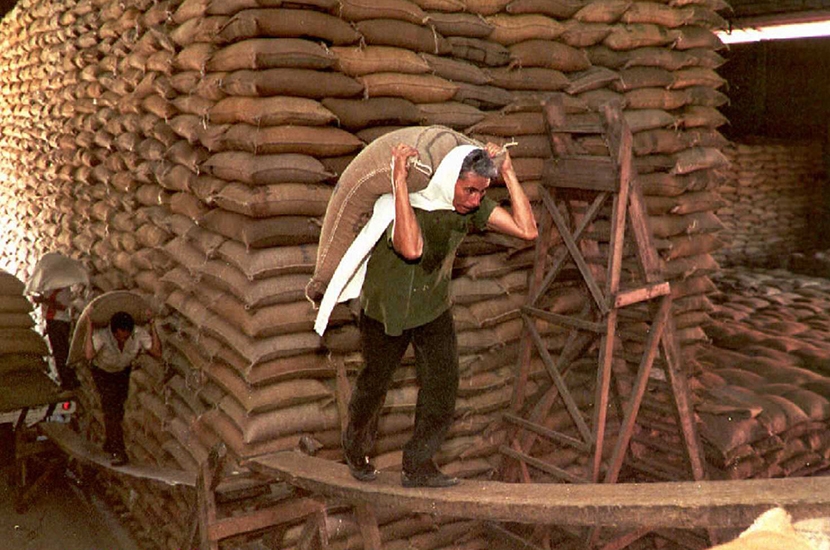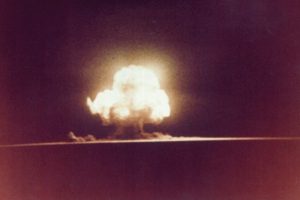In the winter of 1939, at the San Francisco Golden Gate trade fair, an advertorial film called Behind the Cup told the story of El Salvadorean coffee, from seed to cup. America was the world’s biggest consumer, drinking nearly 60 billion cups a year. It opened with a picturesque image of local Indians in traditional costume dancing under the Santa Ana volcano. A trade commentator intoned:
‘Far to the south, high in the mountains of Central America…studded with volcanic peaks, rich in tropical grandeur… Here at the beginning of the coffee season we find gaiety and laughter.’
Bankrolled by the coffee planters, it portrayed a Potemkin village of plantation life. Just seven years before the film’s premiere, nearly 30,000 native Salvadoreans, in revolt after decades of toil and exploitation on the coffee plantations, were butchered by the state.
Augustine Sedgewick has written a dark, exhaustive survey of what one commodity can do to a poor country that has the world’s richest neighbor as a market. His account starts with one of coffee’s founding dynasts, James Hill. From the squalid slums of 19th-century Manchester, Hill escaped via textile trading to El Salvador in 1889. Only independent from Spain in 1821, the country was one of ‘subsistence farmers, with four lawyers and four physicians among its 250,000 citizens’.
Hill married into a local family, inherited some plantations and diligently applied the industrial practices of his homeland to this new Eden. With American and British financial loans and domestic enforcement, land in El Salvador was parceled up, and traditional farmers growing diverse food crops were thrown off and impoverished. By 1928 coffee had become ubiquitous, and in the second half of the century covered a quarter of all El Salvador’s farmland, employing a fifth of its population and accounting for more than 90 percent of its exports.
Hunger permeates this book. Planters like Hill used the threat of it to drive work. When a visiting diplomat, Maurice Duke, visited the plantations in Central America to survey for American investment, he noted approvingly: ‘When a man lags behind, the man’s food is withheld and this quickly puts activity into his unwilling limbs.’ Hill set up field kitchens on his plantations to guarantee that workers would start on time and stay the course, barely fueled by a monotonous diet of bland tortillas and beans. Domestic foods that grew in wild profusion, such as avocados and papayas, were torn up. Ancient fig trees were made into boards. Later in the book, Sedgewick notes that, in 2005, a survey of El Salvador’s coffee workforce were still suffering chronic hunger. In the space of a century, a richly biodiverse country had been reduced to food insecurity and an arid monoculture, condemned to import staples.
The prize for Hill and his fellow planters was trade with America. Itself a former colony, America was initially reluctant to take on the imperial mantle. But as European powers withdrew from Latin America in the 1900s, the US found it easier to trade with countries in its own back yard. Its banks lent money to planters and governments, with increasingly onerous conditions that Latin American countries found hard to repay as coffee prices fluctuated.
In 1921 America lent El Salvador tens of millions of dollars to cover existing debt and economic development, installed customs and agricultural commissioners and threatened military intervention if the country defaulted. The US Supreme Court had oversight on any disputes over this arrangement. The result was a race to the bottom in price that helped drive consumer growth in America as grocery chains used coffee as a loss leader to entice their customers to spend more. Even American importers visiting El Salvador deplored the poor working conditions and appalling pay.
When the revolt did come, in the winter of 1932, British and American governments’ interests were protected by two Canadian warships that were first on the scene. Around 6,000 people rose up with machetes, led by local communist and leftist leaders, ‘to make the workers the owners’. The insurgency was ruthlessly suppressed, with the sons of the 14 elite families patrolling the cities.
The National Guard, armed with machine guns, focused on pursuing the Indians into the countryside and carried out indiscriminate killings — a massacre known as ‘La Matanza’ (The Slaughter). Coffee plantations became killing fields. Young men took off their clothes and sat down in the dirt to disguise themselves as children. Priests would ask their congregations if they were communists; if so, they were singled out and shot. La Matanza made El Salvador a military dictatorship, built on killing and coffee. It enforced production, and coffee paid for its survival.
After World War Two, Latin America was overlooked for economic aid, despite having provided raw materials for the Allies. There was no Marshall Plan, and with the new Cold War, the rise of Castro’s Cuba was seen as a symbol of resistance by the left in Latin America, and a threat to the US in its own backyard. A new wave of violence and repression erupted in the 1970s and 1980s as America poured in billions to fight leftist guerrilla groups, using right-wing death squads that had received training from the US. The Salvadoran civil war was the largest American counter-insurgency and nation-building campaign before Iraq. As many as 75,000 died. James Hill’s own grandson, Jaime, was kidnapped by guerrillas in 1979 and ransomed for $4 million plus a full-page manifesto protesting the workers’ plight in the New York Times. Eventually, George Bush told the Salvadorean government that American support wasn’t bottomless, and peace was signed in 1992.
Sedgewick’s gripping book exposes the dark heart of what goes into making a ubiquitous commodity, cherished every morning, enshrined in the workplace and appreciated after a meal. It provides a devastating answer to the question: ‘What does it mean to be connected to faraway people and places through everyday things?’
This article was originally published in
The Spectator’s UK magazine. Subscribe to the US edition here.

























